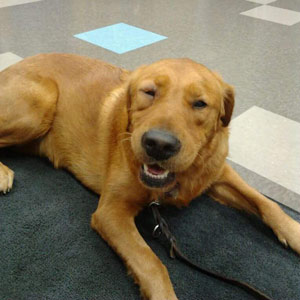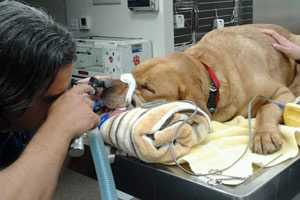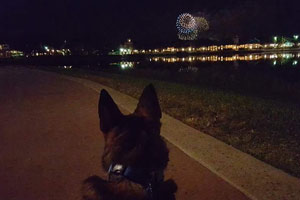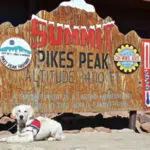Written by Amie Chapman
Summer is officially here and I thought with the upcoming Fourth of July holiday, I would provide some information on how to keep your dogs safe during this season. So instead of writing and sharing as a puppy raiser, this time I will be doing so as a veterinary technician.
Summer is a great time to be out and about with your dog whether it be a puppy in training, active service dog, or a loved family member. But it is also a time of when dogs can be at risk for illness or injury.
This will be my 18th summer working in a veterinary emergency clinic.
The summer is always a busy time there, and I have seen some of the worst things possible happen to dogs and cats. Many things can cause a dog to end up at our clinic. I have seen more than my share of sick and injured animals, many of them preventable. I will touch on some of the more common things we see. There are always going to be events that you can’t prevent in your dog’s life, but there are definitely ways that you can decrease risks to them. This includes all dogs, not just service dogs.
“Taking your dog with you to run errands is not a good idea. Pet dogs are not allowed in most stores and a few minutes in a hot car, even with the windows cracked, can heat up to dangerous temperatures for your dog.”
Many people include their dogs in their summer and or holiday plans.
Vacations, camping trips, day hikes, beach days, afternoon at the park, backyard BBQs, trips to lakes, and more. It is always a fun time until a dog is need of a trip to the ER.
The first thing to be aware of is that although warm weather is great for summer activities, it can also be very harmful to dogs. Dogs can get overheated in warm weather. Don’t over exercise your dog on hot days. Do your playtime or walks early in the morning or after the sun goes down. Always take water with you for your dog when going out on warm days. Taking your dog with you to run errands is not a good idea. Pet dogs are not allowed in most stores and a few minutes in a hot car, even with the windows cracked, can heat up to dangerous temperatures for your dog. Warm pavement can harm paw pads too. Walking or playing on hot pavement can burn feet or can cause paw pads to tear easily. Rule of thumb is if you can’t walk barefoot because it is too hot for your feet, it is too hot for your dog as well. It may look silly to some people, but using dog booties does work to keep feet protected. There is one downside. The only place a dog sweats is their feet. Booties don’t allow for the heat to evaporate quite as well.

Bite wounds happen year round, but because more people are out when the weather is nice more bites happen in the summer time. Following leash laws is the number one way to keep your dogs safe. If you do happen to take your dog somewhere that dogs are allowed off leash, make sure your dog is a good candidate to be there. Whether your dog is shy or the type to push other dogs’ buttons, know when you should walk away from a certain situation. Not every dog is going to get along with every other dog and disagreements will happen, so remember that there will always be a risk in any off leash environment.
Bee stings can affect dogs just like people.
Some dogs are highly allergic to bee stings, while others will not have any reaction at all. Bee stings warrant an immediate vet visit if there is any noticeable facial swelling (regardless of where the sting occurred), hives, vomiting, diarrhea, pale gum color, lethargy, or difficulty breathing. These are sign of an allergic reaction.


In California (and some other states) there are weeds called fox tails. These nasty little buggers can cause lots of problems. The can get stuck in ears (constant shaking of the head is seen), noses (causes violent sneezing fits), and eyes (squinting and pawing at the eyes). The can also penetrate the skin, most commonly in between the toes, and cause some pretty bad infections. They are all over and can be hard to avoid completely, especially when hiking. Always check your dog’s feet when exposed to these areas.
Backyard BBQs are always fun, but do be careful about your dog getting too many treats and/or stealing food off the picnic table. Guests often think it is okay to share food with your dog so make sure everyone knows whether you allow that. We often see dogs with severe upset tummies from over-indulging. Also beware of possible foods that are toxic to dogs. Grapes, raisins, onions, and uncooked meats waiting to go on the grill can be some of the most dangerous. If your pet has ingested something, either call your vet or go to the ASPCA Animal Poison Control website and see if what your dog ate will cause a problem.
Wildlife in your own backyard can also pose a problem.
While skunks aren’t a big threat to hurting your dog, they sure can make them smell bad for weeks. A great formula to bathe your dog in if they do get skunked is: mix 1 quart 3% Hydrogen Peroxide, ¼ cup of Baking Soda, and 1 teaspoon of liquid soap, that can break through grease (like Dawn, it is very pet safe). Let this mixture sit on your dog for 10 minutes (if possible) and rinse thoroughly. This will definitely cut down on the smell, but it will take awhile for it to fully go away. KEEP OUT of the eyes and mouth. Racoons on the other hand can do some major damage or even kill smaller dogs. If raccoons are known to be around you, be on the lookout and consider using a leash in the yard after dark to minimize the risk of an interaction. Be very careful if your dog has an altercation with a racoon—they can bite you as well.
“Current ID tags and microchips are a must for a traveling dog. I also like to make note of where the closest emergency veterinary clinic is to where I will be staying.”
One night we had a dog that came in for being attacked by a raccoon and they both ended up in a lagoon.
The owner jumped in the lagoon to pull his dog out and accidently grabbed the raccoon instead! Everyone was okay in the end, but the dog ended up being treated for bite wounds and pneumonia.
Snakes bites are also a risk with warmer weather so know what type of snakes may be in the area you live or plan to visit. Rattlesnake Antivenin is VERY expensive, but I have seen multiple animals recover from bad snake bites with it.
Many people travel with their dogs during the summer, and camping or trips to lakes are some of the favorite summer destinations. Make sure you are prepared for what your dog may need. First aid kits are great to have in case of minor cuts or torn pads. Life jackets are good for if you are spending time on a boat or in the water. Light up collars are really great to have for night time outdoor activities—we love ours and have different colors for each dog (so we can tell who is who from a distance). Current ID tags and microchips are a must for a traveling dog. I also like to make note of where the closest emergency veterinary clinic is to where I will be staying.
Lastly 4th of July activities—many dogs are not fans of these.
Parades are fun, but large crowds, loud music, horses, and large floats can be very frightening for dogs, especially if they are not used to being in that type of environment. Fireworks are also very intimidating for dogs. Every year multiple phone calls come into the clinic of people wanting to know what they can do for their dog who is terrified of the fireworks going off in their neighborhood. Fireworks cause lot of anxiety for some dogs, so much that they require heavy sedatives. Almost every year I see a dog who has either jumped their fenced back yard and been hit by a car, or a dog that has gone through a window in the house because they are so terrified of the fireworks that they just want to get away. One year we had a call come in from animal control asking us to stand by for a possible dog hit by a plane—that was a first. The officer had been following and trying to get ahold of a dog that was frightened by fireworks for over five miles. The terrified dog somehow found its way to the San Francisco International airport runway and they thought they saw it get hit by one of the planes. The dog ended up jumping into the bay and the Coast Guard was then called in for the search. I still to this day don’t know if that dog was found.
Please keep your dogs in a safe place and stay with them if they have any anxiety.
Plan ahead if you think your dog may require sedatives or anti-anxiety medications. Trust me, you don’t want to sit in the waiting room of an emergency clinic for a couple of hours just to get medication for your dog because you forgot and it is now July 4th and your dog desperately needs them.
Another reminder is to watch what you are doing with yourself if you do plan on bringing your dog for any celebration activity. You are responsible for the safety and well-being of your dog. Many years ago a dog was brought into my work by Animal Control for no fault of his own. His owner had passed out (reason unknown) while watching a firework display and the paramedics were called to transport him to the hospital. The dog was very upset and protective of his owner and wouldn’t allow anyone near the owner. Sadly, the dog was pepper sprayed in order to remove it from the owner so medical treatment could be administered. That night I had to bathe the pepper spray off a very scared and confused dog. This dog didn’t ask to be put in that position and I really didn’t enjoy the headache for two days from the smell of the pepper spray.
Summer can be full of fun activities for all, if you just make sure plan ahead, be aware of the possible risks, and make smart decisions for you and your dog. I wish everyone a happy and safe holiday and summer.











